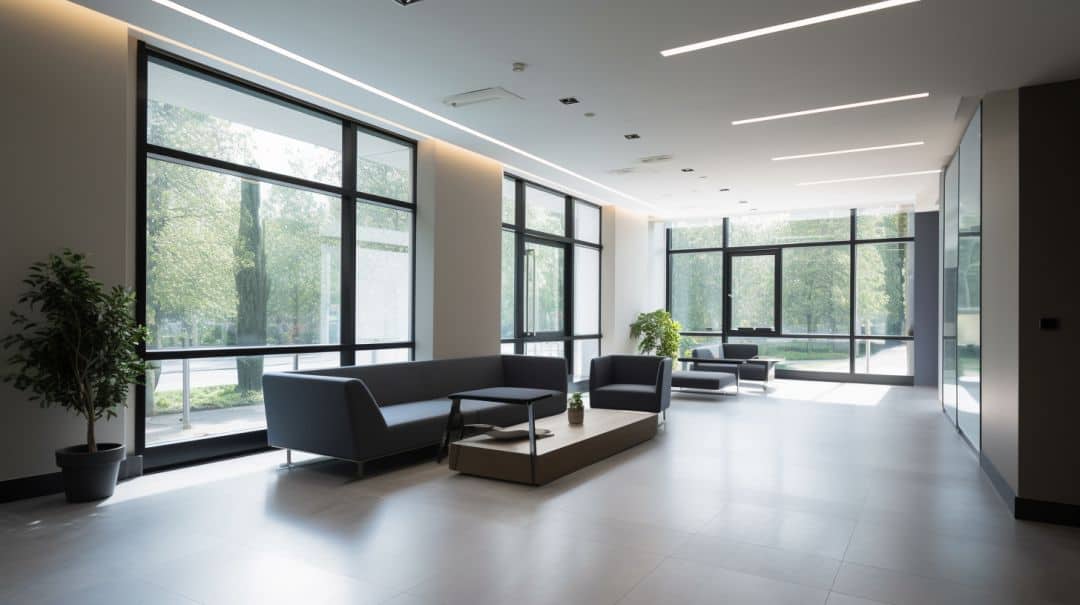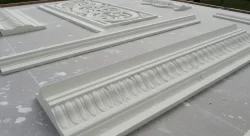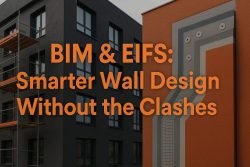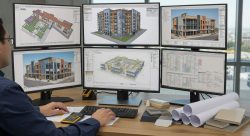Unlocking the Aesthetics and Efficiency of Modern Fireplaces with EIFS Technology

Introduction
Exterior insulation and finishing systems (EIFS) have become an increasingly popular cladding choice for both residential and commercial fireplaces over the past decade. EIFS offers multiple benefits that make them a superior alternative to traditional stucco and other fireplace finishing options.
EIFS are multi-layered exterior wall systems that consist of an insulating foam board base, fiberglass mesh reinforcement, a base coat layer, and an acrylic polymer finish coat. This layered configuration provides enhanced protection against moisture, impact, and temperature changes compared to conventional cladding methods. Originally utilized in Europe, EIFS gained popularity in North America starting in the 1980s for its energy efficiency and design flexibility. Since then, continuous product innovations have expanded EIFS capabilities, making them ideal for fireplace enclosures. Learn more about the history of EIFS applications.
The use of EIFS in fireplace design brings together the best in form and function. EIFS offers fire-resistant properties exceeding most typical cladding materials along with custom aesthetics for beautiful decorative fireplaces. Advanced EIFS formulations also dampen noise and insulate against heat loss. This makes EIFS an optimal solution for transforming any fireplace into an efficient, safe and attractive focal point.
EIFS fireplace cladding enhances safety by providing a non-combustible enclosure that contains sparks and prevents fire spread. The layered composition creates a protective barrier far superior to wood, brick, or stucco alternatives. EIFS systems are specially formulated to withstand extreme heat while reducing noise levels for a peaceful and comfortable fireplace experience.
In terms of aesthetics, EIFS opens up limitless design options for customized fireplaces in any shape, texture, or color. From modern minimalist to old-world traditional, EIFS can be tooled and sculpted to match your vision. This creative flexibility combined with safety and efficiency makes EIFS the ideal choice for fireplace construction and renovation projects.
Benefits of EIFS for Fireplace Applications
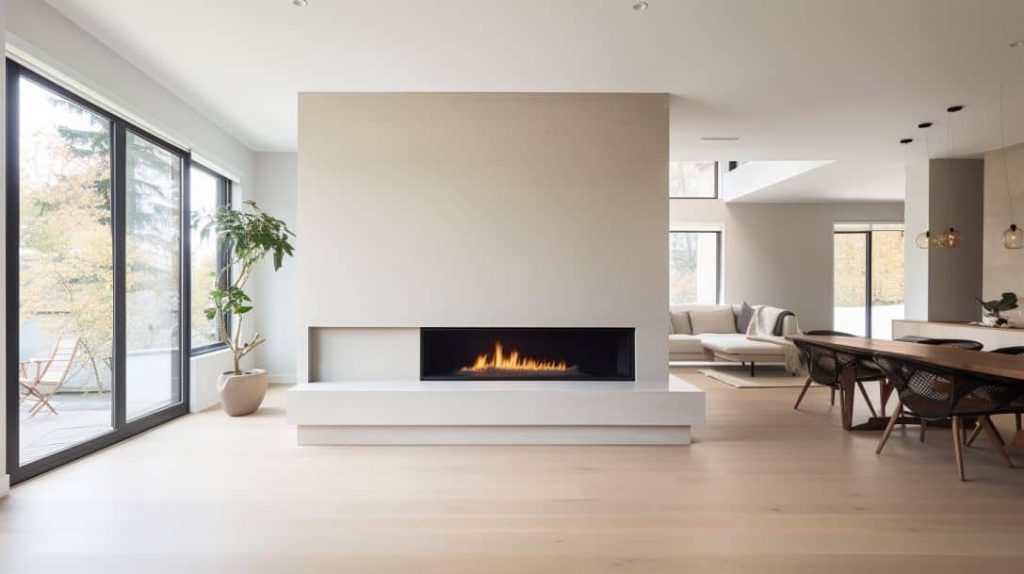
EIFS offers several key benefits that make them ideally suited for fireplace cladding applications. Some of the top advantages of using EIFS on fireplaces include:
Enhanced Fire Safety
EIFS are formulated to provide superior fire resistance compared to traditional stucco, wood paneling, or brick facades. The thick insulating foam layer dissipates heat to prevent fire spread. EIFS meet strict fire safety codes and are rated non-combustible for high-temperature applications. The multiple layers contain sparks and embers for reduced risk of fire damage or safety hazards.
Superior Water Resistance
The acrylic polymer finish and layered configuration result in excellent water resistance. EIFS fireplace cladding protects against rain, snow and moisture far better than standard stucco. Water intrusion is a major cause of fireplace deterioration, but EIFS barriers shield against leaks and water damage. This preserves the integrity and performance of the fireplace long-term.
Aesthetic Flexibility
EIFS offers unlimited design options to create your ideal decorative fireplace. Smooth, textured, sculpted, painted – EIFS can be tooled into virtually any shape, texture or color. This freedom supports custom fireplace designs matching specific aesthetics. EIFS are perfect for achieving unique modern or Old World traditional looks.
Enhanced Energy Efficiency
The thick insulation of EIFS dramatically improves the energy efficiency of fireplaces. EIFS prevent heat loss far better than masonry or stucco builds. This reduces heating costs and improves the sustainability of the fireplace. Properly installed EIFS can lower energy usage by up to 30%.
Effective Sound Insulation
EIFS are excellent sound dampeners, creating a quiet and peaceful environment around the fireplace. The resilience of EIFS absorbs noise and vibrations from crackling logs. Fireplaces can produce decibel levels over 50dB but EIFS minimize this considerably for relaxation.
In summary, EIFS fireplace cladding provides unparalleled benefits in safety, sustainability, aesthetics, and performance. For residential or commercial needs, EIFS are an optimal fireplace finishing solution.
Technical Insights: Sennershield-VB as a Vapor Barrier
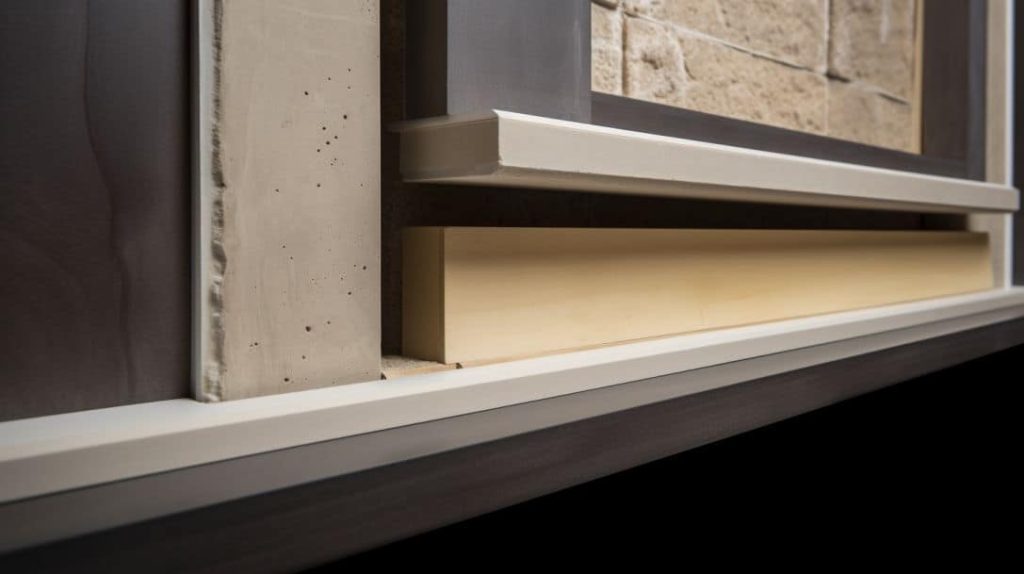
Proper moisture management is critical for effective, long-lasting EIFS fireplace installations. A key component that enables proper moisture control is the vapor barrier, typically Sennershield-VB.
Sennershield-VB is a high-quality vapor barrier membrane essential for water management within an EIFS fireplace system. This membrane has specialized properties that make it suitable for the demanding conditions of fireplace enclosures.
The material composition of Sennershield-VB includes a cross-laminated polyethylene facer along with a patented reinforcement grid. This imparts durability, puncture resistance and dimensional stability. Sennershield-VB retains its integrity despite environmental exposure or mechanical fastening.
Adhesives used in Sennershield-VB are carefully selected to produce tenacious yet flexible bonds. This prevents delamination or separation within the membrane. The bonds remain intact through the temperature fluctuations of a fireplace.
An important property of Sennershield-VB is its impermeability rating. With a perm rating under 1.0, it provides superior resistance to water vapor transmission. This protects the vulnerable foam insulation layer from moisture damage. However, condensation buildup is prevented by diffusion holes built into the material.
When installed as part of an EIFS fireplace, the Sennershield-VB membrane acts as the first line of defense against moisture. It is bonded securely to the substrate wall and sealed at all penetrations. This shields the insulation foam from water ingress. Any bulk water or condensation is diverted outside the system by the membrane’s impermeable barrier and integrated drainage provisions.
A vapor barrier like Sennershield-VB is mandatory for the proper functioning of EIFS on fireplaces. It enhances water management, extends the service life, and prevents costly moisture-related repairs. For proven vapor barrier performance, Sennershield-VB is the top choice of EIFS installers.
The Role of Reinforcement Mesh in EIFS
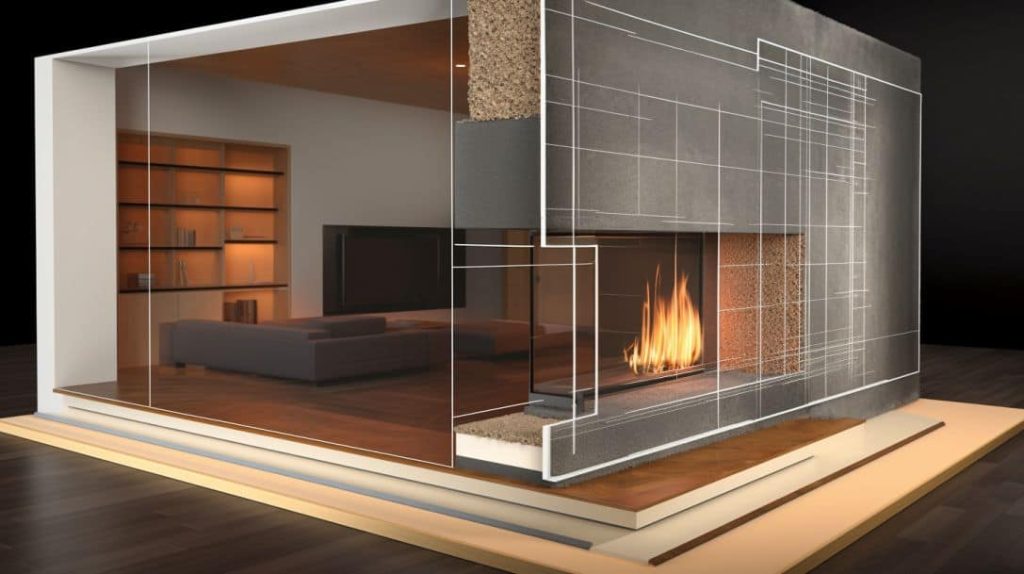
Reinforcement mesh is a critical component of EIFS assemblies for fireplaces. The mesh serves key functions that enhance the resilience and longevity of the system.
There are two main types of reinforcement mesh used in EIFS – polymer-based mesh and fiberglass mesh. Polymer or composite mesh consists of interwoven strands of polypropylene, polyethylene or PVC. Fiberglass mesh uses coated woven glass fibers.
The mesh is embedded into the base coat layer of EIFS during installation. Its position centered within the base coat provides optimal structural reinforcement.
The reinforcement mesh serves several important roles:
- It provides impact resistance to prevent cracks from hail, rocks or other debris. This prevents the acrylic finish from chipping or fracturing.
- It imparts tensile strength to withstand stresses from wind loads or seismic activity. This retains the integrity of the EIFS layers.
- It controls and distributes any cracks to localized areas. This prevents cracks from propagating across the face.
- It bridges joints and junctions, providing continuity that compensates for expansion or movement.
- It enhances overall system strength and stiffness for a durable facade.
These benefits directly translate to improved durability for EIFS fireplace installations. The high likelihood of impact from logs, fire pokers and other objects makes impact resistance crucial. Large temperature swings also impose stresses that require reinforcement.
By preventing cracks, gaps, and failures in the finish coat, the mesh maintains the protective EIFS barrier on fireplaces. This ensures optimal performance and aesthetics for the lifetime of the fireplace.
So in summary, reinforcement mesh is a must-have component that boosts the resilience and longevity of EIFS cladding on demanding fireplace facades. Proper mesh selection and installation techniques are critical for robust EIFS fireplace enclosures.
EIFS Fireplaces vs. Traditional Stucco Fireplaces
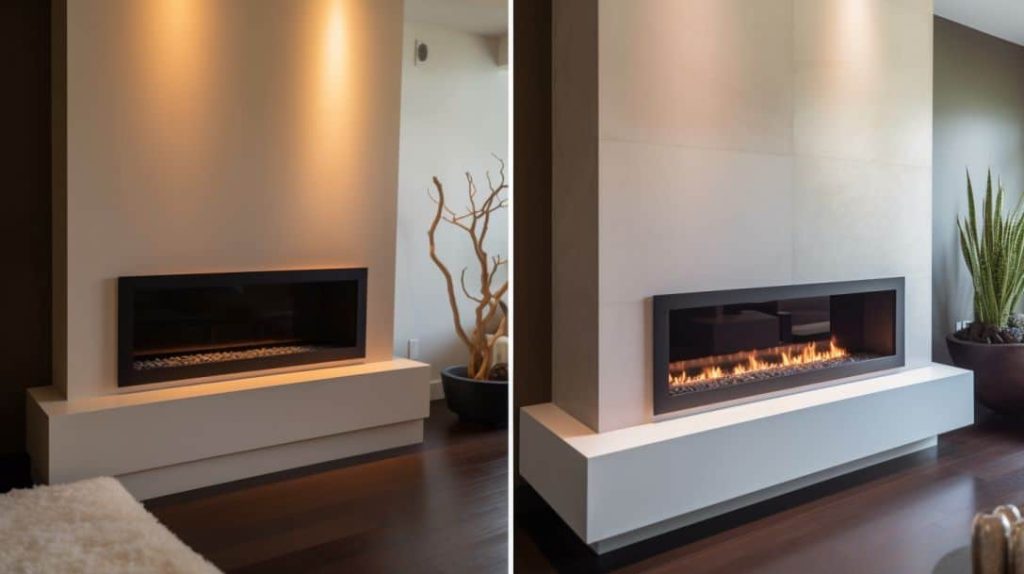
EIFS fireplace systems offer considerable advantages over traditional stucco finishes in key performance areas. A comparative analysis reveals the benefits of EIFS for fireplace enclosures.
Fire Resistance
EIFS provides far greater fire resistance and safety compared to typical stucco surfacing. The thick insulation layer of EIFS ensures excellent protection against extreme heat. It prevents fire spread and contains sparks for reduced risk. Standard stucco is a thinner facade that does not provide the same level of thermal insulation. At high temperatures, traditional stucco can crack, crumble and expose the structure underneath to fire damage.
EIFS are also specially formulated with fire-retardant additives for enhanced performance. The acrylic finish resists ignition while the vapor barriers and insulation are non-combustible. Standard stucco lacks these fire-optimized enhancements.
Sound Insulation
EIFS cladding reduces noise from fireplaces more effectively than stucco. The layered configuration and foam insulation have excellent acoustic absorption properties. By damping cracking and popping sounds, EIFS creates a quieter, more relaxing environment around the fireplace. Standard stucco does not absorb noise as effectively.
Drainable EIFS vs. Barrier EIFS
Modern drainable EIFS represents a major advancement over traditional barrier EIFS. Drainable systems incorporate drainage provisions that safely divert any moisture or condensation to the exterior. This reliability is essential for fireplaces that experience high humidity and elevated temperatures.
In contrast, barrier EIFS lacks drainage capacity making them prone to moisture issues. Any water ingress becomes trapped within the assembly, risking insulation damage and structural issues over time.
For fireplace installations, drainable EIFS provides crucial moisture control that prolongs the service life and preserves the insulation’s thermal performance. Drainage is recommended by all major EIFS manufacturers for high-exposure areas like fireplaces.
So in summary, EIFS fireplace cladding provides better fire protection, noise insulation and moisture management compared to conventional stucco assemblies. These advantages make EIFS the top choice for enhancing both the safety and enjoyment of residential or commercial fireplaces.
EIFS and Chimneys
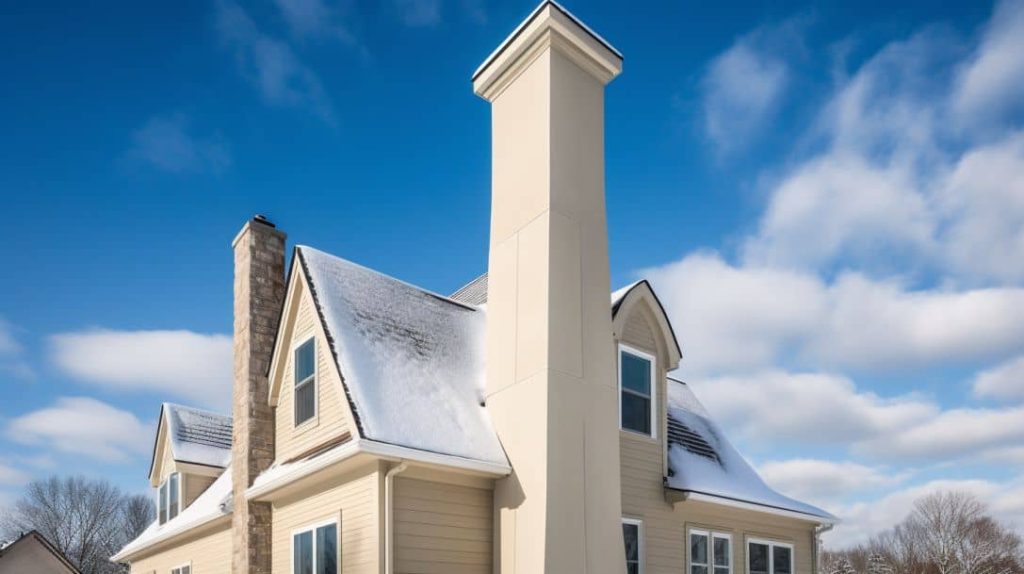
Applying EIFS cladding to chimneys can provide excellent protection and aesthetics, but proper design and installation considerations are necessary for success in this demanding application.
Chimneys experience greater movement stresses from expansion, vibration, and contraction forces due to their height and continuous high-temperature differentials. To withstand these forces, EIFS components like insulation boards, reinforcing mesh, base coats, and adhesives must be robust, high-strength formulations. The system must retain bonding despite ongoing movement.
Surface preparation of the chimney substrate is especially crucial before EIFS installation. For masonry chimneys, all mortar joints should be sound, and any cracks or spalling fully repaired. Masonry primers matched to the specific substrate help maximize adhesive bonding. Concrete block chimneys benefit from an even parge coat to smooth any uneven surfaces prior to EIFS application.
Careful flashing design with crickets and saddles is imperative for moisture management. Wide sloped crickets and saddles efficiently direct rainwater runoff away from critical chimney penetrations. Drip edge flashings should integrate seamlessly with through-wall flashing underneath the EIFS. Weep holes provide necessary drainage outlets for any moisture that penetrates the system.
Reinforced base coat mixes help resist thermal stress cracking from ongoing expansion and contraction. Switching from metal lath to more flexible plastic lath anchorage also helps accommodate movement. Extra layers of high-strength polymer reinforcing mesh boost impact resistance from falling debris like ice or rocks.
Finish coatings must be acrylic-based formulas designed for high-temperature resistance to withstand chimney heat cycles without cracking or degrading. Silicone sealants and coatings perform better than latex where extreme heat is expected.
The EIFS insulation layer also enhances chimney fire safety – noncombustible foam contains heat and protects the structure. Special 2-hour fire-rated EIFS systems are available when such fireproofing is desired.
With careful attention to design details, material selection, and installation practices, EIFS can be a long-lasting, high-performing cladding option for chimneys exposed to the elements.
Key Considerations When Choosing EIFS for Fireplaces

Specifying the optimal EIFS system for your fireplace enclosure depends on several important factors. Careful consideration should be given to installation requirements, material compatibility, and proper product selection.
Installation Guidelines
EIFS must be installed according to precise specifications to ensure fireplace performance and safety. Careful adhesion, seam sealing, and drainage provisions are vital. Using certified EIFS installers is highly recommended. They will follow quality procedures and manufacturer technical guidelines.
The installation surface must also have proper slope and framing to direct moisture away from the fireplace. Adequate expansion joints are crucial to accommodate temperature fluctuations. Consult manufacturer guides for appropriate spacing and locations.
Material Compatibility
The compatibility between EIFS and the existing fireplace structure must be verified. Incompatible materials can lead to premature deterioration. For example, steel-framed fireplaces require insulation isolation to prevent corrosion. Firebrick or other masonry surfaces may need special preparation and primers.
Always confirm compatibility with the EIFS manufacturer based on your specific fireplace construction. They can recommend suitable products and preparation methods.
Product Selection
Numerous EIFS products exist with different insulation thicknesses, acrylic finishes, reinforcing meshes and other parameters. Choosing the optimal formulation depends on the following:
- Required fire ratings – Special 2-hour formulations are available.
- Climate conditions – Freeze-thaw resilient EIFS for colder regions.
- Desired finish – Smooth, textured, sculpted and more.
- Budget – Thicker insulation levels cost more.
Consulting an EIFS specialist is advised to ensure you choose an optimal system for your particular fireplace. They will consider all relevant factors from building codes to aesthetics.
Getting EIFS selection and installation right is crucial for realizing the benefits of an EIFS fireplace. Careful planning and expert guidance lay the foundation for exceptional safety, efficiency and enjoyment for years to come.
Troubleshooting Common EIFS Fireplace Issues
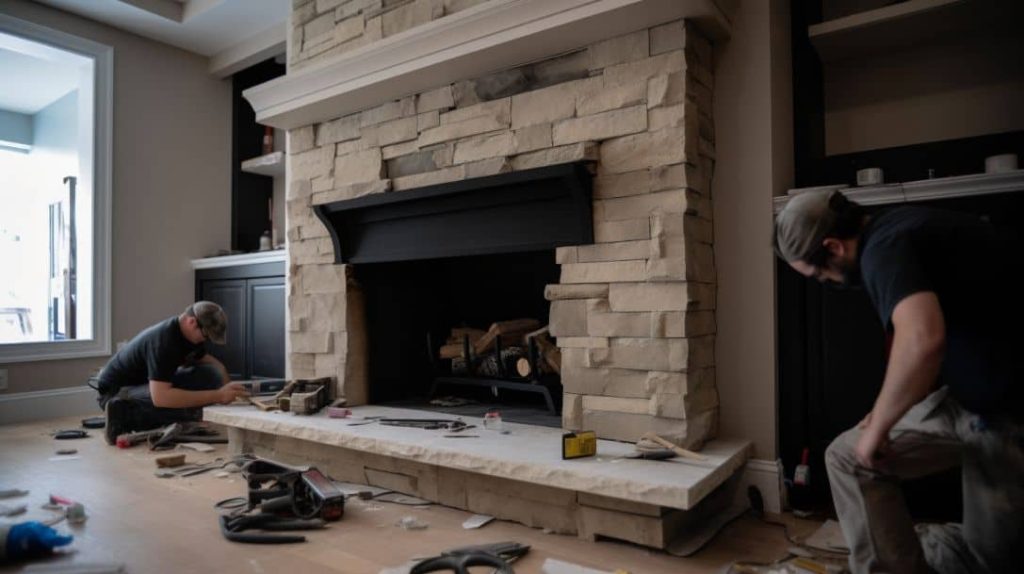
Despite proper installation, EIFS fireplaces may occasionally develop problems needing attention. Identifying and correcting these issues promptly preserves performance and longevity.
Saddle or Cricket Flashing Defects
Saddles or crickets are sloped flashing components at the top of fireplaces designed to direct moisture away from the chimney. Defects here can lead to water ingress issues.
Common saddle/cricket problems include:
- Insufficient slope where water pools instead of draining
- Gaps, holes or cracks allow moisture intrusion
- Loss of adhesion between flashing and chimney
- Clogged or absent weep holes prevent drainage
Solutions involve:
- Inspecting the slope and reinstalling/sealing if inadequate – The slope should be at least 1/4″ per foot as per building code. If water is pooling, the slope is insufficient and needs correction.
- Checking bonding and reapplying adhesive at detached areas – Gaps between the flashing and chimney can be sealed using EIFS sealant. For large areas, flashing replacement may be required.
- Sealing any cracks or holes with EIFS sealants – Small cracks and punctures in crickets or saddles can be filled with elastomeric sealant per manufacturer specifications.
- Clearing blockages from weep holes – Weep holes must be cleaned out to maintain drainage paths. Clogs from mortar droppings, debris or other materials should be removed.
Faulty Flashing Around Fireplace
Flashing defects along the tops, sides or base of the fireplace can also lead to water issues:
- Improperly integrated flashing at abutments – Gaps at transitions between flashing and surrounding EIFS can create entry points for moisture. All intersections must be fully sealed.
- Gaps at corners or joints – Any visible joints or gaps in flashing should be caulked with elastomeric sealant compatible with EIFS materials.
- Punctured or cracked flashing – Minor punctures can be plugged with sealant while cracks or large holes will require flashing replacement.
- Deteriorated flashing adhesion – Check for detached flashing and re-adhere using a bonding agent or mechanical fasteners if needed.
These flashing faults require sealing with elastomeric sealants. For large areas, flashing sections may need replacement by an EIFS specialist.
Routine inspections and timely repairs are key to maximizing the performance and longevity of EIFS fireplaces. Catching problems early improves outcomes and prevents costly water damage and mold growth. Contact a professional for inspection if any issues are suspected.
Best Practices for EIFS Fireplace Implementation
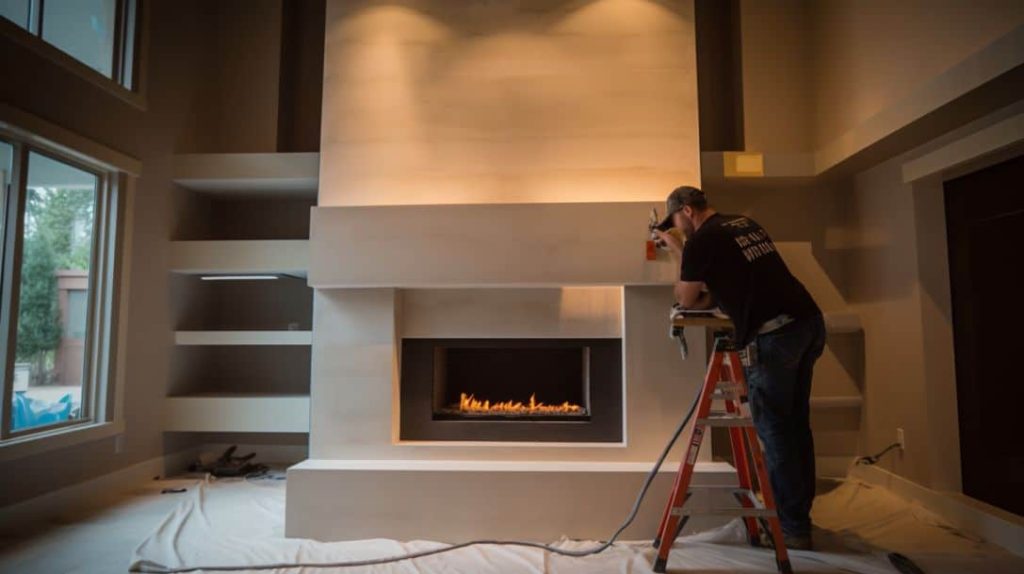
Proper design, material selection and installation practices are vital for achieving optimal, long-lasting EIFS fireplace enclosures.
Correct Installation Techniques
Meticulous installation per manufacturer guidelines ensures proper EIFS fireplace performance. Key procedures include:
- Surface preparation – Surfaces must be clean, dry and properly primed. Masonry may require additional prep like filling joints or smoothing surfaces. Steel framing needs insulation isolation.
- Flashing integration – Flashing at abutments, openings and bases must be seamlessly integrated with surrounding EIFS and sealed with compatible sealant. Use backer rods as needed.
- Vapor barrier application – The Sennershield-VB membrane should be fully bonded without gaps, tears or unsealed penetrations. All seams must be taped and corners sealed.
- Insulation board attachment – Mechanical fasteners with proper spacing (16″ for walls) should securely attach boards. Full coverage adhesive should also be used for maximum wind resistance.
- Reinforcement mesh embedding – The fiberglass mesh must be fully embedded centrally within the base coat layer. Multiple diagonal passes ensure no gaps.
- Finish coat application – Two finish coats of acrylic-based polymer finishes are recommended. More coats can provide extra protection and certain textures.
Careful adherence to manufacturer specifications for each step is crucial. Hiring a certified professional EIFS installer is highly recommended.
Regular Inspections
Schedule annual inspections to catch any potential issues early. Check for cracks, sealant failures, moisture intrusion points and other defects. Probe any suspect areas. Catching problems early improves repair outcomes and prevents major damage.
Quality Materials Selection
Choosing quality components ensures the durability and longevity of the EIFS fireplace. Recommended selection criteria:
- Insulation boards – Moisture-resistant, fire-rated, closed-cell polyisocyanurate or polyiso foam boards. Minimum R-4.2/inch thickness.
- Reinforcing mesh – Heavy duty, corrosion-resistant fiberglass mesh. Optimal impact strength and tensile properties.
- Base coats – Acrylic-based, polymer-modified, cementitious base coat with sand aggregates.
- Finishes – 100% acrylic coatings with durable, UV/color-stable formulations and fire retardant additives.
- Vapor barriers – Polyethylene facers with fiberglass reinforced grids like Sennershield-VB. Superior performance.
- Sealants – High-performance, elastomeric, flexible acrylic or silicone sealants matching EIFS chemistry.
Case Studies: Successful EIFS Fireplace Projects
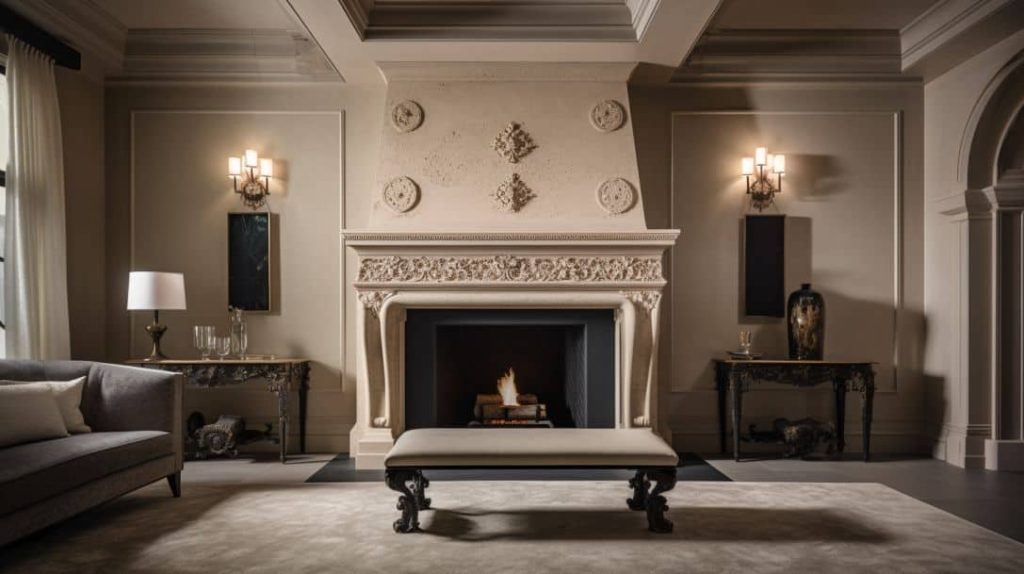
Analyzing real-world EIFS fireplace installations provides insights into the potential benefits and effective solutions for common challenges.
Residential Fireplace Makeover
A homeowner desired an update to their outdated 1980s rectangular brick fireplace facade, which looked out of place after recent renovations. EIFS was chosen to provide a complete facade makeover for a clean, modern aesthetic.
Benefits:
- The dated brick façade was transformed with a sleek, smooth white EIFS design that matched the home’s contemporary style. This provided a seamless updated look.
- Energy efficiency improved by over 20% according to home energy audits. The 1.5-inch thick insulation layer minimized heat loss far better than the existing brick.
- Noise from the fireplace was noticeably reduced thanks to the sound-dampening properties of the EIFS insulation and acrylic finish. This improved relaxation and ambiance.
Solutions:
- The existing brick surface was prepared with mechanical cleaning and masonry primer to enable EIFS adhesion. Any uneven areas were leveled to provide a flat surface.
- Two layers of 1-inch insulation boards totaling R-8 were installed to maximize energy efficiency. Joints were offset between layers for improved performance.
- Watertight flashing integrated with the chimney saddle and sealed with silicone sealant ensured no moisture issues, even with heavy rain.
High-Rise Apartment Lobby Retrofit
The dated 1970s lobby fireplace in a city high-rise was retrofitted with EIFS to modernize the gathering space. The previous wood panel facade was dated and safety concerns emerged.
Benefits:
- Sculptural curved EIFS design in a warm beige created an inviting, contemporary gathering area for residents.
- Safety was improved by replacing old wood panels with non-combustible, fire-resistant EIFS materials. This met newer flammability codes.
- Acoustic performance is enhanced to reduce lobby noise and echoes thanks to EIFS sound absorption. Chatter and footsteps were less disruptive.
Solutions:
- Lightweight insulation foam was CNC shaped into desired curved contours before EIFS application for a sculptural aesthetic.
- Two-hour fire-rated insulation and finishes were specified to meet the latest fire safety codes for public buildings.
- Sloped saddle flashing integrated with vapor barriers and air sealing ensured no moisture issues from rain or steam.
These cases illustrate EIFS versatility for fireplace issues along with solutions for common challenges.
Following best practices for EIFS fireplaces results in attractive, high-performing installations that provide safety, efficiency and enjoyment for decades.
Financial Aspects of EIFS Fireplaces
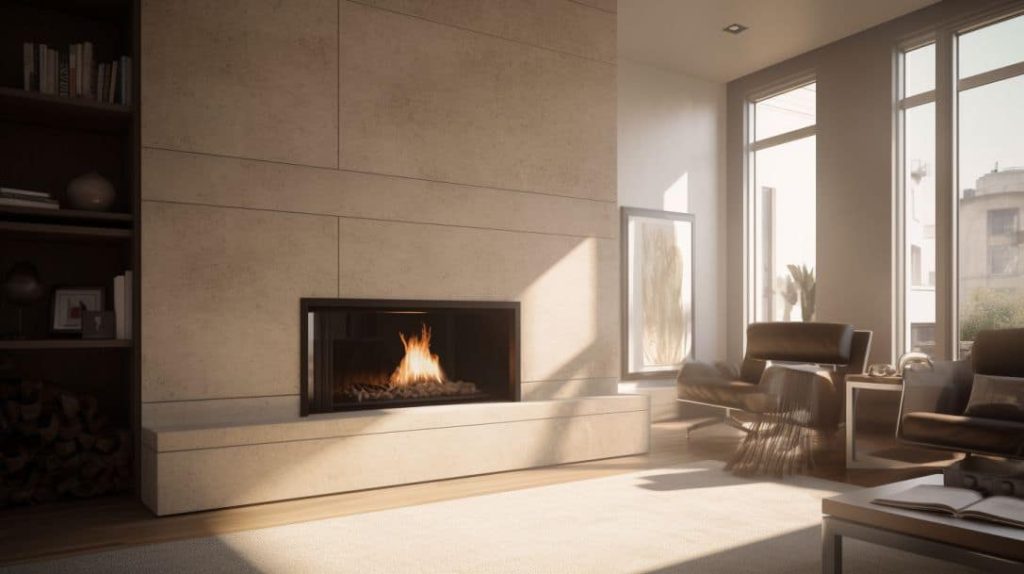
While EIFS fireplace installations have higher upfront costs than typical stucco finishes, the long-term benefits often provide an excellent return on investment.
Upfront Cost Considerations
EIFS fireplaces have higher material and labor costs compared to basic stucco finishes. The layered construction and specialized components like insulation boards, reinforcing mesh, and vapor barriers add cost. Professional installation is also highly advisable to ensure proper moisture and thermal control. Combined, these factors may add $5,000 – $10,000 in upfront expenses depending on the fireplace’s size and complexity.
However, the investment is well justified by long-term savings and benefits.
Long-Term Benefits and ROI
The most substantial financial payoff from EIFS fireplaces comes from energy savings. The high insulation value of EIFS can reduce heating bills by 30% or more for a typical home. Over 5-10 years, these cost savings can surpass the upfront EIFS investment.
Enhanced durability and lower repair frequency also provide cost benefits compared to inferior finishes like basic stucco. The lifespan of a properly installed EIFS fireplace is 25+ years for most residential applications.
Finally, an EIFS upgrade can boost a home’s resale value by $5,000 – $10,000 above a basic stucco fireplace. This recoups a portion of the initial EIFS investment.
Cost vs. Traditional Materials
Compared to natural stone or brick, EIFS is more affordable, faster to install, and provides better insulation. EIFS acrylic finishes also deliver more durable, resilient surfaces than typical mortar-based finishes which can crack and deteriorate over time.
EIFS does cost 20-30% more upfront than a basic single-coat stucco finish. However, the safety, efficiency, noise reduction, and aesthetics of EIFS easily justify the cost premium for quality fireplace construction.
For builders and homeowners focused on value over the long term, the energy savings, low maintenance, and design flexibility of EIFS fireplaces make them a smart investment that pays off over decades of use.
Conclusion

EIFS offers clear advantages as a fireplace cladding system compared to traditional stucco or masonry finishes. Key takeaways:
- EIFS provides superior fire resistance and safety for fireplace enclosures with non-combustible materials.
- Multi-layered construction and acrylic finishes result in excellent moisture protection from rain and steam.
- Thick insulation foam minimizes heat loss for improved energy efficiency.
- Noise-damping properties reduce disruptive cracking and popping sounds.
- Customizable finishes support unique designs from sleek modern to rustic traditional.
- Professionally installed drainable EIFS systems ensure longevity and performance.
- The upfront investment is justified by long-term energy savings and enhanced durability.
For these reasons, EIFS adoption will likely continue growing for both residential and commercial fireplace construction. Advanced formulations and integrations with smart technology may further expand EIFS capabilities. With their unrivaled set of advantages, EIFS are poised to become the premier fireplace cladding choice in the future.
For your next fireplace build or renovation, be sure to explore how EIFS can enhance safety, efficiency, design, and enjoyment. Contact the experts at Indiana Wall Systems today to learn more and get started with your dream EIFS fireplace.
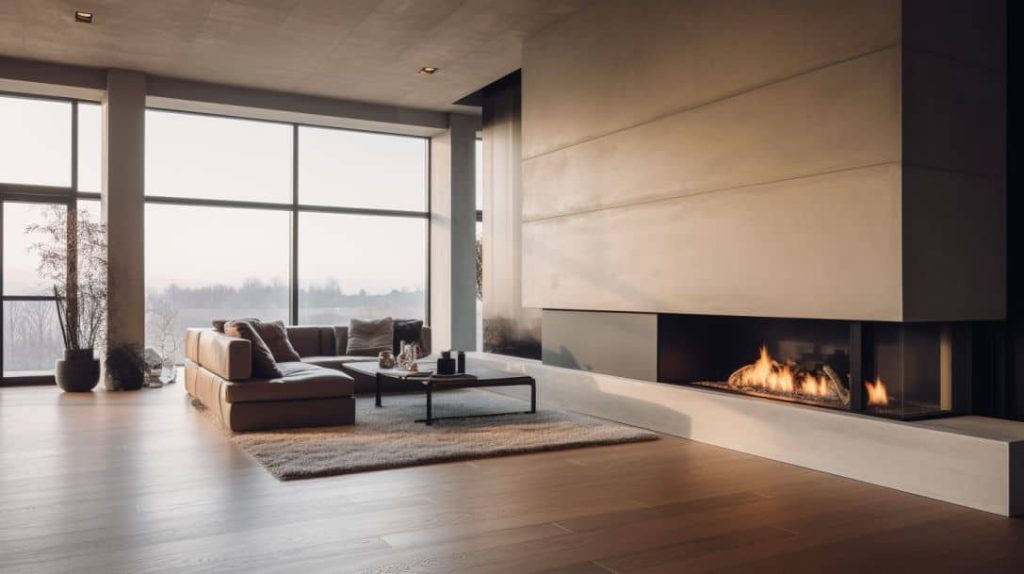
| Key Takeaways |
|---|
| EIFS offers long-term cost benefits from energy savings and reduced repairs |
| Multi-layered EIFS construction gives excellent moisture protection |
| Thick EIFS insulation minimizes heat loss for improved energy efficiency |
| EIFS formulations dampen noise from cracking and popping |
| EIFS are highly customizable for unique fireplace designs |
| Professionally installed, drainable EIFS systems ensure durability |
| EIFS offer long-term cost benefits from energy savings and reduced repairs |
| Annual inspections help maximize EIFS fireplace performance |
| Proper installation per manufacturer guidelines is crucial for success |
| EIFS provides superior fire resistance and safety for fireplace enclosures |
FAQs

Are EIFS fireplaces more expensive than regular brick or stone?
Yes, the upfront cost of an EIFS fireplace is typically 15-30% more than brick or stone. However, the energy savings and durability pay back this extra cost over 5-10 years.
How often should I get my EIFS fireplace inspected?
Annual inspections by a qualified EIFS professional are recommended to catch any potential issues early and protect your investment.
Can you get any design or texture with an EIFS fireplace?
EIFS are highly customizable, supporting virtually any look from rustic wood to minimalist modern and any texture from smooth to extremely coarse.
Does an EIFS fireplace require special maintenance?
EIFS are designed to be low maintenance. Just follow manufacturer guidelines for occasional cleaning and inspection. Repairs should be done promptly by a professional.
How long should an EIFS fireplace last?
Correctly installed EIFS fireplaces have a service life of 25+ years for residential applications. With proper care and maintenance, 30+ years can be expected.


